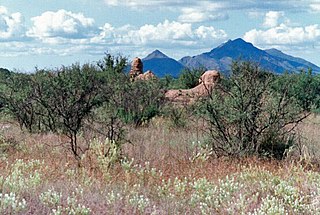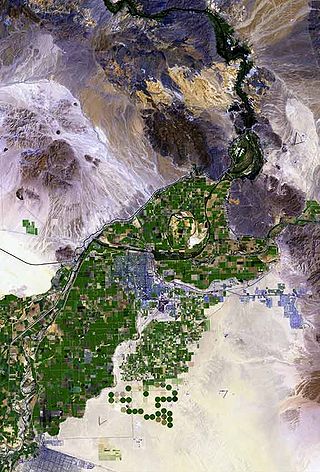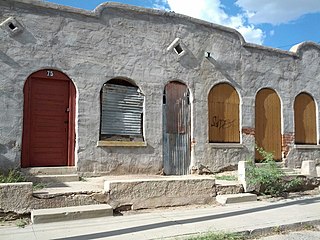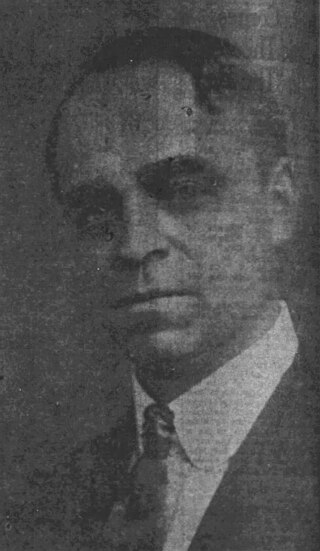Related Research Articles

Tucson is a city in and the county seat of Pima County, Arizona, United States, and is home to the University of Arizona. It is the second-largest city in Arizona behind Phoenix, with a population of 542,629 in the 2020 United States census, while the population of the entire Tucson metropolitan statistical area (MSA) is 1,043,433. The Tucson MSA forms part of the larger Tucson-Nogales combined statistical area. Both Tucson and Phoenix anchor the Arizona Sun Corridor. The city is 108 miles (174 km) southeast of Phoenix and 60 mi (100 km) north of the United States–Mexico border.

Interstate 19 (I-19) is a north–south Interstate Highway located entirely within the US state of Arizona. I-19 travels from Nogales, roughly 90 meters (300 ft) from the Mexican border, to Tucson, at I-10. The highway also travels through the cities of Rio Rico, Green Valley, and Sahuarita.

Pima County is a county in the south central region of the U.S. state of Arizona. As of the 2020 census, the population was 1,043,433, making it Arizona's second-most populous county. The county seat is Tucson, where most of the population is centered. The county is named after the Pima Native Americans, also known as Tohono O'odham, who are indigenous to this area.

Interstate 11 (I-11) is an Interstate Highway that currently runs for 22.6 miles (36.4 km) on a predominantly northwest–southeast alignment in the U.S. state of Nevada, running concurrently with U.S. Route 93 (US 93) between the Arizona state line and Henderson. The freeway is tentatively planned to run from Nogales, Arizona, to the vicinity of Reno, Nevada, generally following the current routes of I-19, I-10, US 93, and US 95. Planners anticipate upgrading two existing highway segments to carry future I-11: US 93 in Arizona from Wickenburg to the Nevada state line on the Mike O'Callaghan–Pat Tillman Memorial Bridge over the Colorado River and US 95 in Nevada from the Las Vegas Valley to Tonopah. In 2024, officials will begin replacing I-515 signs in Las Vegas with I-11 signs and adding I-11 signs on US 95 north of Downtown Las Vegas, which will extend I-11 northward about 30.5 miles (49.1 km). An extension of the Interstate northward along US 95 to Mercury, Nevada, is planned after that. An exact alignment for I-11 has yet to be determined outside of these sections; a number of corridor alternatives, however, have been identified for further study and refinement. The building of I-11 in Arizona is also facing local opposition from conservation groups.

Pima Community College (PCC) is a public community college in Pima County, Arizona. It serves the Tucson metropolitan area with a community college district consisting of five campuses, four education centers, and several adult education learning centers. It provides traditional and online instruction for over 144 programs. The college also offers workforce training, non-credit personal interest classes and post-baccalaureate certificates. PCC is one of the largest multi-campus community colleges in the United States, with relative ranking varying between fourth and tenth largest. PCC is accredited by the Higher Learning Commission.

The Spanish missions in the Sonoran Desert are a series of Jesuit Catholic religious outposts established by the Spanish Catholic Jesuits and other orders for religious conversions of the Pima and Tohono O'odham indigenous peoples residing in the Sonoran Desert. An added goal was giving Spain a colonial presence in their frontier territory of the Sonora y Sinaloa Province in the Viceroyalty of New Spain, and relocating by Indian Reductions settlements and encomiendas for agricultural, ranching, and mining labor.

Daniel Anthony Olivas is an American author and attorney.

KOHT is an urban-leaning rhythmic contemporary station serving Tucson, Arizona, and is licensed to Marana,. It has been owned by iHeartMedia, Inc. since July 30, 2001 and broadcasts with an ERP of 6 kW. The station's playlist is primarily Rhythmic Top 40, hip hop and R&B. Its studios are located north of downtown Tucson along Oracle Road, while the transmitter site is near the Tortolita Mountains in unincorporated Pima County.

La Misión de San Gabriel de Guevavi was founded by Jesuit missionary priests Eusebio Kino and Juan María de Salvatierra in 1691. Subsequent missionaries called it San Rafael and San Miguel, resulting in the common historical name of Mission Los Santos Ángeles de Guevavi.
The Sobaipuri were one of many indigenous groups occupying Sonora and what is now Arizona at the time Europeans first entered the American Southwest. They were a Piman or O'odham group who occupied southern Arizona and northern Sonora in the 15th–19th centuries. They were a subgroup of the O'odham or Pima, surviving members of which include the residents of San Xavier del Bac which is now part of the Tohono O'odham Nation and the Akimel O'odham.

The Gila River Valley is a multi-sectioned valley of the Gila River, located primarily in Arizona. The Gila River forms in western New Mexico and flows west across southeastern, south-central, and southwestern Arizona; it changes directions as it progresses across the state, and defines specific areas and valleys. The central portion of the river flows through the southern Phoenix valley region, and the final sections in southwestern Arizona form smaller, irrigated valleys, such as Dome Valley, Mohawk Valley, and Hyder Valley.
Roy Place was a Tucson, Arizona architect.

Arizona is a landlocked state in the Southwestern region of the United States. Arizona is part of the Four Corners region with Utah to the north, Colorado to the northeast, and New Mexico to the east; its other neighboring states are Nevada to the northwest, California to the west and the Mexican states of Sonora and Baja California to the south and southwest. It is the 6th-largest and the 14th-most-populous of the 50 states. Its capital and largest city is Phoenix.

The Arizona Sun Corridor, shortened Sun Corridor, is a megaregion, or megapolitan area, in the southern area of the U.S. state of Arizona. The Sun Corridor is comparable to Indiana in both size and population. It is one of the fastest growing conurbations in the country and is speculated to double its population by 2040. The largest metropolitan areas are the Phoenix metropolitan area – Valley of the Sun, and the Tucson metropolitan area – The Old Pueblo. The regions' populace is nestled in the valley of a desert environment. Similar to Southern California, the urban area extends into Mexico, reaching the communities of Heroica Nogales and Agua Prieta.

Throughout its history, Tucson, Arizona has had a large and influential Mexican American community. Tucson was majority Mexican/Mexican American even by the early 20th century.

Barrio Libre is a neighborhood in Tucson, Arizona notable for its existence as a relatively unchanged 19th-century Hispanic neighborhood of close-packed row houses. Houses in the barrio are typically adobe with very plain detailing, reflecting the area's history as a district of townhouses for Mexican ranching families.
Patricia Preciado Martin is an author and researcher who specializes in oral history and the history of Arizona. She was one of the first to document, write and share stories of Mexican Americans in Tucson, Arizona.

Fred Ormal Goodell (1876-1961) was an Arizona politician who served three consecutive terms in the Arizona State Senate from 1917 through 1922. Very active in the Masons, he served in all of their major posts in Arizona, including being the Grand Master of Masons in Arizona, the Grand Commander of Knights Templar in Arizona, the Grand Master of A. & S. M. of Arizona, and the High Priest of R. A. M. of Arizona. He served as the county comptroller for Pima County for 21 years, from 1935 to 1956.

Brian Lopez is a Mexican-American singer-songwriter, guitarist, producer and recording artist from Southern Arizona. His music is influenced by grunge rock, cross-border musical traditions and has come to epitomize the sound of the 21st-century American Southwest. A significant figure in the development of the Southwest psychedelic rock movement, Lopez has established a number of noted bands including Mostly Bears and Xixa, and played with internationally recognized artists Calexico, Giant Sand, KT Tunstall, and Nouvelle Vague. His solo albums include Ultra, Static Noise, and Prelude. Lopez's musical style has been compared to Nick Drake, Elliott Smith, Jeff Buckley, and Radiohead.
References
- ↑ Portillo, Jr., Ernesto (2016-01-09). "Pioneering Otero family will hold reunion this weekend". Arizona Daily Star. pp. A006. Retrieved 2022-03-12.
- ↑ "Child of Tucson barrio hits on class, gender, race themes". Arizona Daily Star. 2021-02-28. pp. E1. Retrieved 2022-03-12.
- ↑ "Otero, continued". Arizona Daily Star. 2021-02-28. pp. E4. Retrieved 2022-03-12.
- ↑ "Lydia R Otero | UA Profiles". University of Arizona . Retrieved 2021-02-21.
- ↑ Otero, Lydia R. (2003). Conflicting visions: Urban renewal, historical preservation and the politics of saving a Mexican past. The University of Arizona. hdl:10150/280374. OCLC 1118675292.
- ↑ Faderman, Lillian; Timmons, Stuart (2006). Gay L.A. : a history of sexual outlaws, power politics, and lipstick lesbians. New York: Basic Books. ISBN 978-0-465-02288-5.
- ↑ The Oxford encyclopedia of Latinos and Latinas in the United States. New York: Oxford University Press. 2005. ISBN 978-0-19-515600-3.
- ↑ Podolisky, Robin (29 December 1988). "Linkage". LA Weekly. Retrieved 2022-03-12.
- ↑ "Tucson won't remove Pancho Villa statue, despite conservative group's request". NBC News. 17 December 2018. Retrieved 2022-03-12.
- ↑ Bregel, Emily (May 1, 2018). "Diane Keaton buys adobe in Tucson's Barrio Viejo for $1.5 million". Arizona Daily Star. Retrieved 2022-03-12.
- ↑ Rosenblum, Mort (2012-02-20). "An American City Disappearing Before My Eyes". The New York Times. Retrieved 2022-03-12.
- ↑ "BRLA 2011 Southwest Book Awards". BRLA 2011 Southwest Book Awards. 2011. Retrieved 20 February 2021.
- ↑ Goodman, Adam (2013). Otero, Lydia R.; Perales, Monica (eds.). "The Promise of New Approaches and Persistence of Old Paradigms in Mexican American History". Journal of American Ethnic History. 32 (3): 83–89. doi:10.5406/jamerethnhist.32.3.0083. ISSN 0278-5927. JSTOR 10.5406/jamerethnhist.32.3.0083.
- ↑ González, Jerry (2012). "Review of LA CALLE: Spatial Conflicts and Urban Renewal in a Southwest City". Southern California Quarterly. 94 (3): 389–392. doi:10.1525/scq.2012.94.3.389. ISSN 0038-3929. JSTOR 10.1525/scq.2012.94.3.389.
- ↑ Sandul, Paul J. P. (2012). "Review of La Calle: Spatial Conflicts and Urban Renewal in a Southwest City". The Public Historian. 34 (1): 134–136. doi:10.1525/tph.2012.34.1.134. ISSN 0272-3433. JSTOR 10.1525/tph.2012.34.1.134.
- ↑ Joyce, Barry (2012-12-01). "Lydia R. Otero, La Calle: Spatial Conflicts and Urban Renewal in a Southwest City". Winterthur Portfolio. 46 (4): 308–309. doi:10.1086/669749. ISSN 0084-0416.
- ↑ "A new year, a new Southwest Books of the Year!". Pima County Library. February 1, 2021.
- ↑ Yacono, Candice (2020-04-13). "Freeway Dreams". Los Angeles Review of Books . Retrieved 2022-03-12.
- ↑ Burns, W. James (2020). "In the Shadows of the Freeway: Growing Up Brown and Queer by Lydia R. Otero (review)". Journal of Arizona History . 61 (3): 726–729. ISSN 2689-3908.
- ↑ HERNANDEZ, LIANE (March 15, 2019). "TUCSON WOMEN TO BE HONORED AT DOLORES HUERTA CELEBRACIÓN DE LA MUJER". Arizona Daily Star . Archived from the original on May 30, 2020.
- ↑ Kelty, Bennito L. (October 11, 2021). "Author & historian Lydia Otero to headline Pima Library's annual LGBTQ+ talk". TucsonSentinel.com. Retrieved 2022-03-12.
- ↑ "OAH Distinguished Lecturer Profile | OAH". www.oah.org. Retrieved 2022-03-12.